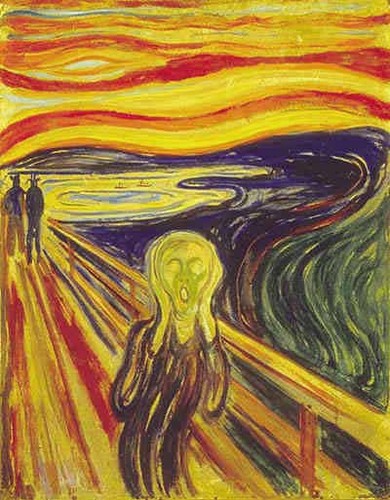His original Tempera on Cardboard is the most well-known version and can be found in Oslo’s National Gallery (Nasjonalmuseet) while his least liked version is crayon on cardboard. After the first was sold he made another two years later, in pastel on cardboard, and it is a lot less gloomy than the original. Probably because of the money he was getting. He then painted another Tempera on Cardboard in 1910 because the others had sold.
His diverse binding media (tempera, oil and pastel) suffer a common problem today; the brilliant and bold synthetic pigments to make 'screaming colors pose a challenge for the long-term preservation of Munch's artworks. The challenge is moisture and it is the reason they are rarely exhibited.

Scream 4 from 1910. Image: The Munch Museum.
Scholars using a combination of in situ non-invasive spectroscopic methods and synchrotron X-ray techniques their non-destructive experiments on micro-flakes originating from the 1910 version of The Scream.
It clearly exhibits signs of degradation in different areas where cadmium-sulfide-based pigments have been used: cadmium yellow brushstrokes have turned to an off-white color in the sunset cloudy sky and in the neck area of the central figure. In the lake, a thickly applied opaque cadmium yellow paint is flaking. Throughout its existence, several elements have played a role in the deterioration of the masterpiece: the yellow pigments used, the environmental conditions and a theft in 2004, when the painting disappeared for two years.
For that reason, it is preserved in a protected storage area in the Munch Museum, in Norway, under controlled conditions of lighting, temperature (about 18°C) and relative humidity (about 50%). The new study provides clues about the deterioration mechanism of cadmium-sulfide-based paints, with significant implication for the preventive conservation of The Scream.
They also found that the impact from light is minor.
The study of the painting was integrated with investigations of artificially aged mock-ups. The latter were prepared using a historical cadmium yellow pigment powder and a cadmium yellow oil paint tube that belonged to Munch. Both mock-ups had a similar composition to the lake in the painting. The study shows that the original cadmium sulfide turns into cadmium sulfate in the presence of chloride-compounds in high-moisture conditions (relative humidity, or RH ?95%). This happens even if there is no light.
"The right formula to preserve and display the main version of The Scream on a permanent basis should include the mitigation of the degradation of the cadmium yellow pigment by minimising the exposure of the painting to excessively high moisture levels (trying to reach 45% RH or lower), while keeping the lighting at standard values foreseen for lightfast painting materials. The results of this study provide new knowledge, which may lead to practical adjustments to the Museum's conservation strategy", explains Irina C. A. Sandu, conservation scientist at the Munch Museum.





Comments